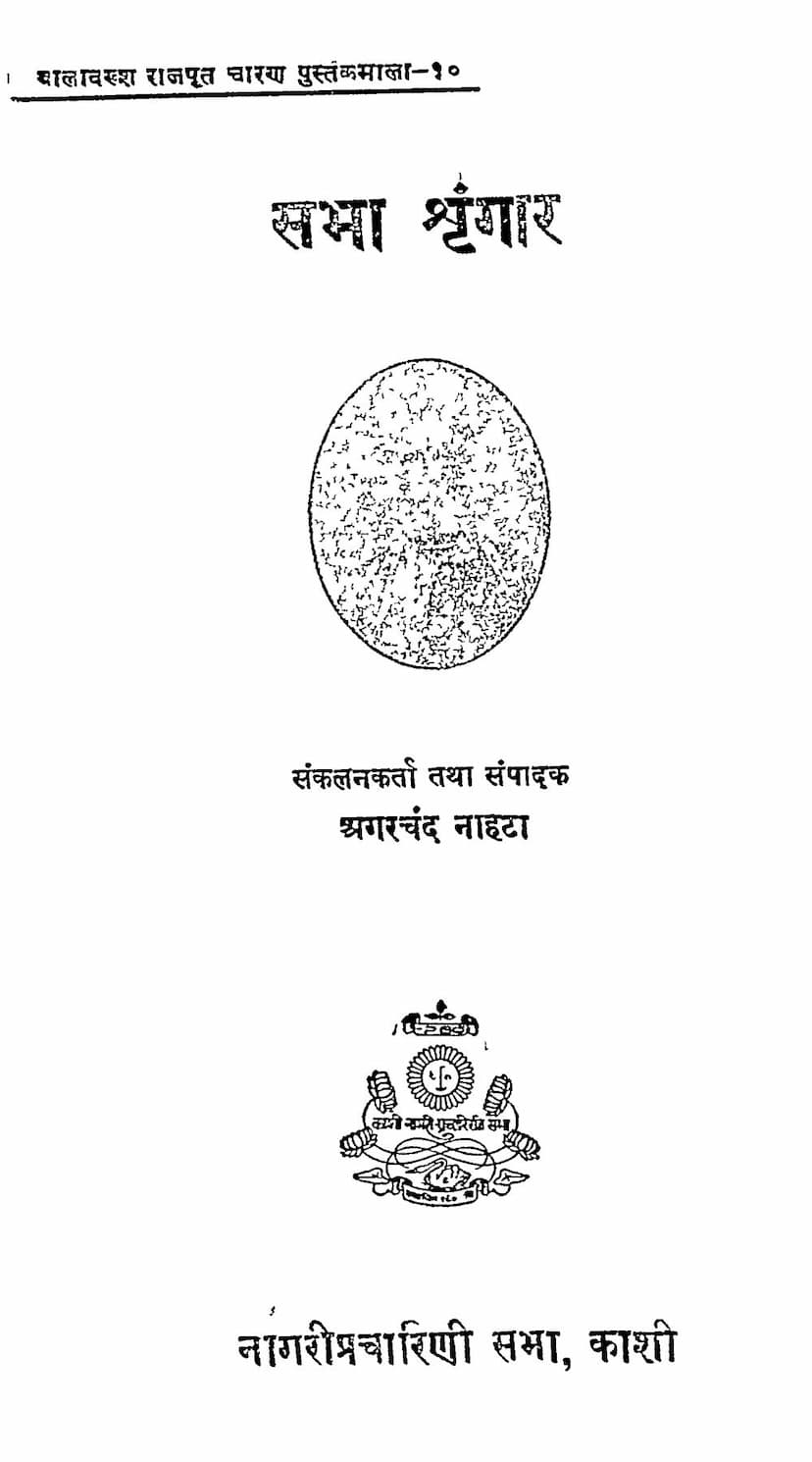Sabha Shrungar
Added to library: September 2, 2025

Summary
Here is a comprehensive summary of the Jain text "Sabha Shrungar," based on the provided pages:
Title: Sabha Shrungar (or Varnan Sangrah - Collection of Descriptions)
Author: Agarchand Nahta
Publisher: Nagri Pracharini Sabha, Kashi
Catalog Link: https://jainqq.org/explore/010755/1
Overview:
"Sabha Shrungar" is a significant compilation of descriptive literature, often referred to as "Varnak Sahitya" (descriptive literature) in Indian traditions. The book, edited by Agarchand Nahta, is part of the "Balbhadra Rajput Charan Pustak Mala," a series initiated with a generous donation from Barhat Balabakhshji to preserve historical and poetic works by Rajputs and Charans. The publication aims to enrich Hindi literature and safeguard these valuable texts for posterity.
Purpose and Scope:
The "Sabha Shrungar" is a collection of descriptions of various subjects, categorized into ten main departments. It is not a single work by one author but a compilation from multiple "Sabha Shrungar" texts, drawing from various manuscripts. The primary goal is to present a comprehensive and organized repository of descriptive passages that were considered exemplary and widely accepted in public discourse and artistic creation. These descriptions serve as a valuable resource for poets, artists, orators, and scholars, providing vivid imagery and detailed information about diverse aspects of life, culture, and the natural world.
Key Features and Content:
The book is structured into ten departments, each covering a specific thematic area:
- Department 1: Descriptions of Countries, Cities, Forests, Animals, Birds, Lakes, and Rivers. This section includes extensive lists of geographical locations, city descriptions (often idealizing their prosperity and order), various types of forests with lists of trees, fauna, and aquatic bodies. It highlights the evolution of geographical knowledge and nomenclature.
- Department 2: Descriptions of Kings, Royal Families, Ministers, Chakravartis (Universal Monarchs), Ravana, Royal Courts, Assembly Halls, Elephants, Horses, Weapons, and Warfare. This department delves into the lives and attributes of rulers, the grandeur of royal courts, the structure of armies, and the depiction of battles. It offers insights into medieval political and military life, including details about royal titles, officials, and weaponry.
- Department 3: Descriptions of Men and Women. This section includes descriptions of men, their qualities, and the portrayal of both virtuous and wicked individuals. It also details the attributes of women, including descriptions of heroines, separated lovers (virahini), and sometimes negative portrayals of ill-intentioned women. It notes the geographical specificity of women's names from different regions.
- Department 4: Descriptions of Nature. This covers various aspects of nature, such as dawn, dusk, sunrise, moonrise, and the six seasons. It highlights the literary embellishments used to depict natural phenomena.
- Department 5: Descriptions of Arts and Sciences. This section enumerates various arts and skills prevalent during the period, offering a glimpse into the intellectual and creative pursuits of the time.
- Department 6: Descriptions of Castes and Occupations. This department provides valuable lists of various social groups, professional castes, and their respective trades, shedding light on the social hierarchy and economic activities of the era.
- Department 7: Descriptions of Deities, Spirits, and Other Beings. This covers the pantheon of deities, spirits like Vetala, and other supernatural entities, reflecting the religious and folk beliefs of the time. It includes specific details about Jain religious elements like the Samavasarana, Vitaraga, and Gachchhas.
- Department 8: Descriptions Related to Jainism. This is a crucial section for understanding the Jain religious and philosophical context. It includes descriptions of sacred places, practices, scriptures, and key figures within Jainism, such as Tirthankaras, Samavasarana, Jinavani, and various Gachchhas.
- Department 9: General Ethical Descriptions. This section contains moral teachings, proverbs, and observations on human behavior, societal conduct, and the consequences of actions. It explores concepts like virtue, vice, duality, and the importance of right conduct.
- Department 10: Descriptions of Food, Festivals, and Daily Life. This department covers various culinary items, sweets, food-related terms, festive occasions, rituals, clothing, ornaments, and other aspects of daily life, providing a rich tapestry of cultural practices.
Editorial Approach and Significance:
Agarchand Nahta's meticulous editing is a highlight of this work. He compiled and synthesized information from multiple manuscripts of "Sabha Shrungar," consolidating similar themes and providing comparative readings where necessary. This approach enhances the usability and comprehensiveness of the collection. The inclusion of Sanskrit texts like "Ratnakosha" and "Niti Nirupan" in the appendix further increases its value.
The "Sabha Shrungar" is recognized for its rich vocabulary and the artistic quality of its descriptions. It serves as a vital primary source for historians, linguists, cultural anthropologists, and literary scholars studying medieval Indian society, language, art, religion, and literature. The work exemplifies the tradition of "Varnak Sahitya" and its contribution to understanding the cultural continuity and evolution in India.
Contribution to Literature:
The book's publication is a testament to the efforts of the Nagri Pracharini Sabha and Agarchand Nahta in preserving and disseminating valuable cultural heritage. It opens up a new area of research in Hindi literature, particularly concerning descriptive compositions, and encourages further exploration of similar extant materials in various regional languages. The text also demonstrates the interconnectedness of cultural practices across different communities in medieval India, including the influence of Islamic culture during the Mughal period, as seen in the inclusion of terms related to administrative and courtly life.
In essence, "Sabha Shrungar" is more than just a collection of descriptions; it is a window into the social, cultural, religious, and literary landscape of medieval India, meticulously curated for scholarly and general appreciation.